Traveling across our country’s most populated state is on track to get a lot easier in the coming years. This week as we continue our series on BIG projects, we feature the much anticipated California High-Speed Rail project. One of the biggest projects in our state, the multi-billion dollar California High-Speed Rail took a big step forward this past summer when it moved from the design phase into the initial construction of the first segment of its first phase from Fresno to Madera.
Using clean renewable energy, the California High-Speed Rail will provide an alternative transportation choice that will help keep the state’s booming projected population growth moving, while preserving its natural environment and working towards its carbon emission reduction goals. Riding the California High-Speed Rail will help remove cars from the state’s already congested freeways helping to reduce emissions and the need to expand these highways and construct new airport runways and terminals to accommodate for more capacity.
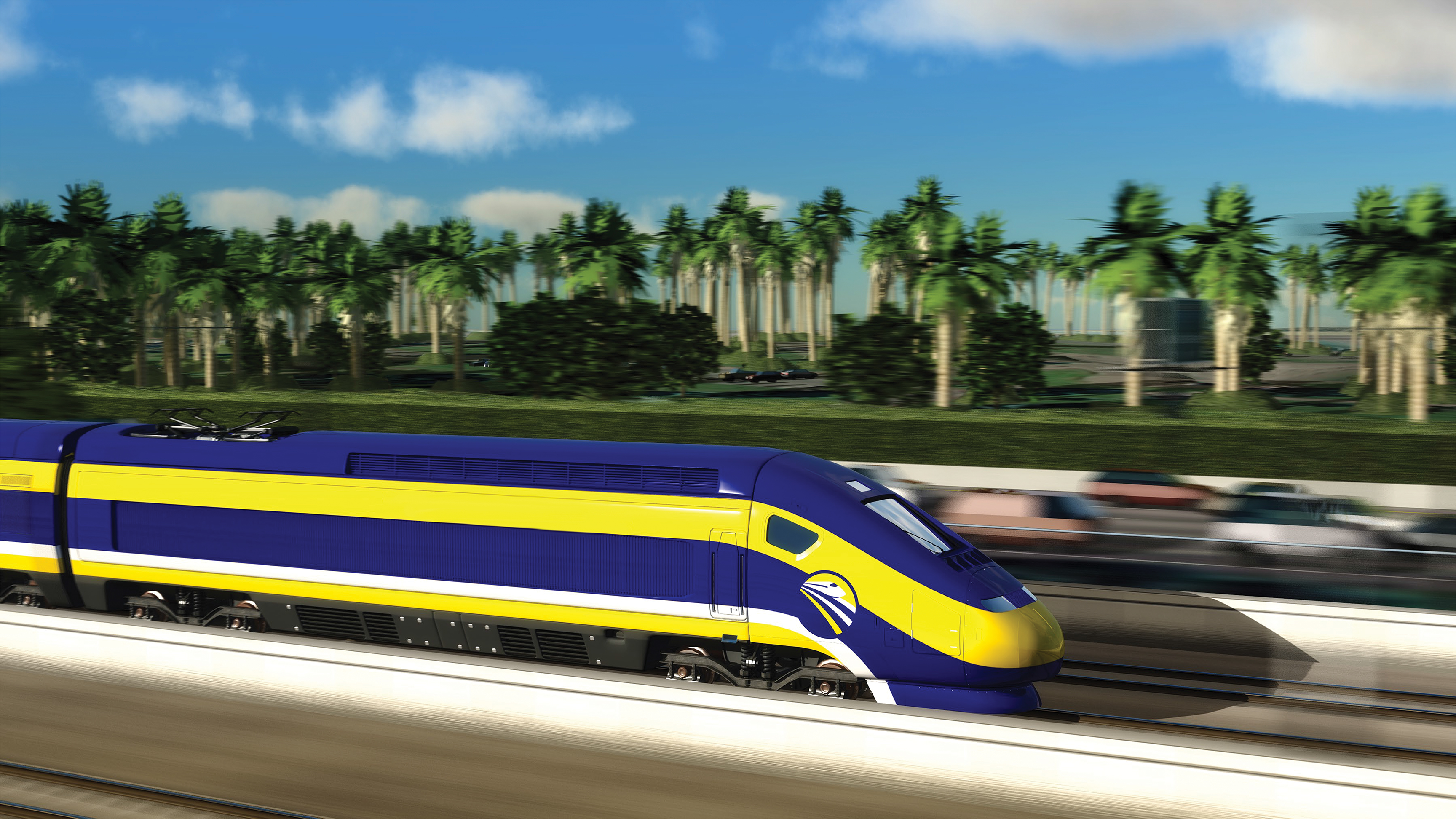
An artist’s conception of a California High-Speed Rail car.
(Credit: California High-Speed Rail)
When complete, the California High-Speed Rail will whisk passengers along the rail line between the San Francisco Bay area and Los Angeles Basin (and eventually from Sacramento south to San Diego) at speeds over 200 m.p.h. But travel times aren’t the only thing the project is speeding up. It is also helping to speed up the state’s economy by providing thousands of new jobs for Californians in construction, operations, maintenance and the transit oriented development businesses that will spring up near the stations along the route. It is also responsible for significant investments in improving existing rail infrastructure across the state.
As with any mega project, the California High-Speed Rail has had its fair share of critics, but it hopes to win over the opposition and follow in the foot steps of other great Californian transformative projects that were also once criticized (Golden Gate Bridge, anyone?).
This week as we continue our series on BIG projects, we invite you to come “all aboard” as we hear from Michelle Boehm, Southern California Regional Director, California High-Speed Rail Authority. Ms. Boehm talks about the project’s challenges and successes to date, what the project is doing to keep the public informed and up to date on its progress, and what future riders can look forward to. We welcome her insights.
– – –
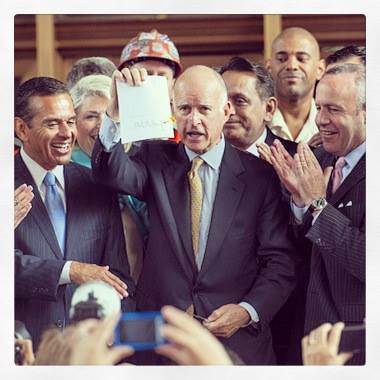
California Governor Jerry Brown signing S.B. 1029 at Los Angeles Union Station.
(Credit: The California High-Speed Rail Authority’s Instagram account)
When did the idea for a high-speed rail across California originate and how did the project gain momentum?
The idea for high-speed rail across California actually began back in the 1970s during Governor Jerry Brown’s first two terms as California’s Governor. As you may already know, Japan has enjoyed high-speed rail since 1964 and just celebrated the 50th anniversary of its Shinkansen Bullet Train. Countries in Europe including France, Spain, Italy, Germany, Austria, Sweden, Belgium, the Netherlands, Russia and the United Kingdom (today all connected as part of a Trans-European high speed rail network), and Asia including China, South Korea and Taiwan soon followed suit by developing their own high-speed rail systems.
The California High-Speed Rail Authority (Authority) was created in 1996 and the program gained momentum in November 2008 when California voters passed Proposition 1A, the $9.95 billion bond measure to help fund high-speed rail in California. Another milestone was in 2012 when California’s Legislature passed Senate Bill (SB) 1029. This appropriated $3.3 billion of federal grant funds from the American Recovery and Reinvestment Act (ARRA) and $4.7 billion of Prop 1A funds for the high-speed rail program.
In June 2014, California’s Legislature approved the 2014-2015 Budget which allocates $250 million of cap and trade proceeds and 25 percent annually of all future cap and trade proceeds for high-speed rail. These steady streams of funding have helped accelerate the program and allow the Authority to build the project concurrently in various parts of the state.
Has the project’s vision and mission changed over time?
While the method by which the high-speed rail program has been implemented has changed since the initial project description, the Authority’s vision and mission has remained consistent: to build a transformative high-speed rail program that connects California’s major population centers and economies with a fast, clean mode of transportation.
As outlined in Proposition 1A, the system will zip passengers from San Francisco to the Los Angeles Basin in under three hours, at speeds of more than 200 mph. In addition to bringing the various regions of the state together, the high-speed rail system will also help reduce California’s traffic congestion, reduce air pollution and greenhouse gas emissions and discourage urban sprawl through the development of station communities and transit orientated development. California’s population is estimated to reach 50 million by 2050, and the cost of adding to the state’s existing infrastructure by simply building more airport runways and highways is estimated to be more than twice the cost of building the high-speed rail system. Building high-speed rail isn’t a luxury, but it’s a necessity to prepare for the future.
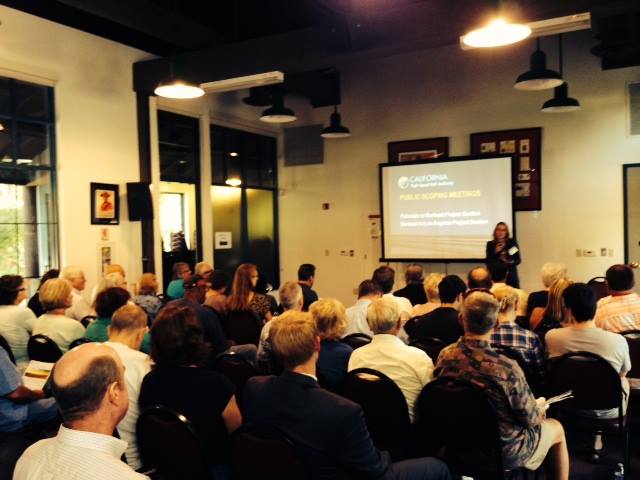
Credit: California High-Speed Rail Authority Facebook Page
What public involvement methods have been the most helpful to explaining the purpose and need of the project early on?
In the last two years, the Authority has been committed to hosting public community meetings throughout the state. This allows residents that may be impacted by the program or are simply seeking an update on progress to ask questions of our engineering, environmental and other experts. Just this past August, the Authority hosted seven public scoping meetings in the Palmdale to Burbank and Burbank to Los Angeles Project Sections. The purpose was to gather official public comments about various proposed alignments and high-speed rail stations that will be considered in our environmental studies in the Southern California region moving forward.
In addition, the Authority has regional offices in Fresno, San Jose and Los Angeles and outreach teams that meet regularly with local stakeholders and the public. Authority staff members often speak at transportation, environmental and small business events and workshops throughout the state to educate the public about our program and the many job opportunities available.
In the past year, the Authority has undertaken an outreach strategy that targets Millennials and focuses on college and university outreach. Senior staff members including CEO Jeff Morales have spoken to students in fields that are related to high-speed rail implementation (engineering, planning, transportation, environmental policy, public policy). Through these talks, the Authority has encouraged Millennials to get involved, via social media, and spread the latest news and updates regarding the high-speed rail program.
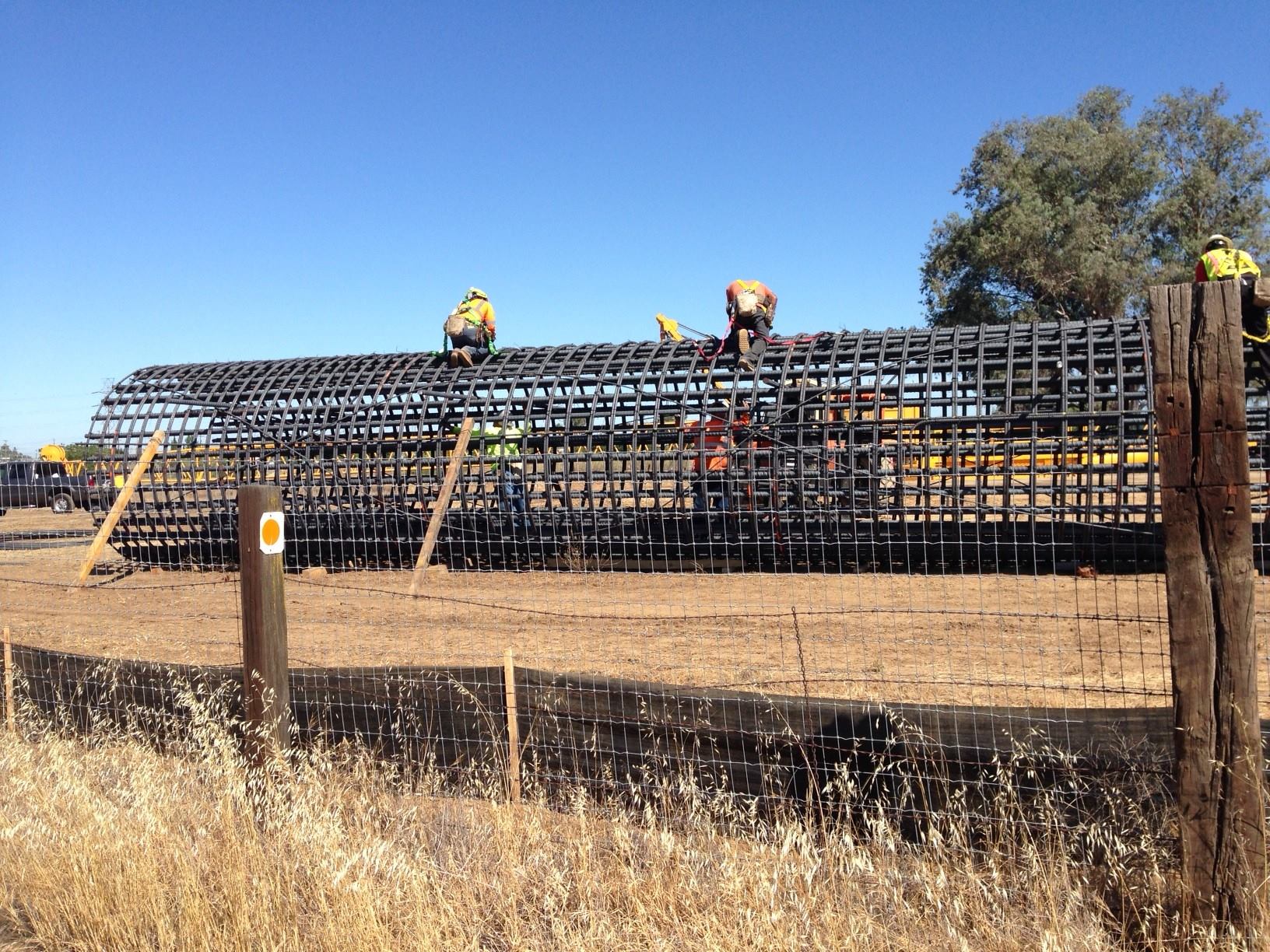
Construction jobs are only one of many types of jobs the California High-Speed Rail will create in the state.
(Credit: California High-Speed Rail Facebook Page)
What do you consider the California High-Speed Rail Authority’s biggest success to date?
Putting Californians to work, especially in the Central Valley, is one of the Authority’s biggest successes to date. The Central Valley has been particularly slow to recover from the national recession, and the construction industry faces more than 30 percent unemployment. High-speed rail construction will create 20,000 construction jobs annually for the next five years. These jobs will go to the people who need them the most and provide a significant boost to California’s economy as a whole.
As of June 30, 2014, there are 156 certified small businesses and 832 full-time workers involved in the high-speed rail program. There are also 21 certified Disabled Veteran Business Enterprises working on the program right now. The Authority has an aggressive 30 percent Small Business participation goal in the program, which includes a 10 percent Disadvantaged Business Enterprise goal and a 3 percent Disabled Veteran Business Enterprise goal.
This is only the beginning. As high-speed rail continues to expand service from the Bay Area to the Los Angeles Basin, it will generate an additional estimated 67,000 jobs annually for 15 years. The jobs won’t only be in the construction industry, but high-speed rail will promote growth in several other sectors. Permanent public and private sector employees will be responsible for operating and maintaining the high-speed rail system. In addition, there will be restaurants, shops, etc. that will be built around future high-speed rail stations.
The California High-Speed Rail project finally began preliminary construction after years of planning and contention. What was the biggest challenge to moving forward and how was it overcome?
All big projects face controversy. The Golden Gate Bridge faced more than 2,000 lawsuits in its time and was termed the “upside-down rat trap that will mar the beauty of the bay.” BART was once called the “train to nowhere.” And the California State Water System and the University of California System were both passed with single-vote margins. Where would we be without these transformative projects?
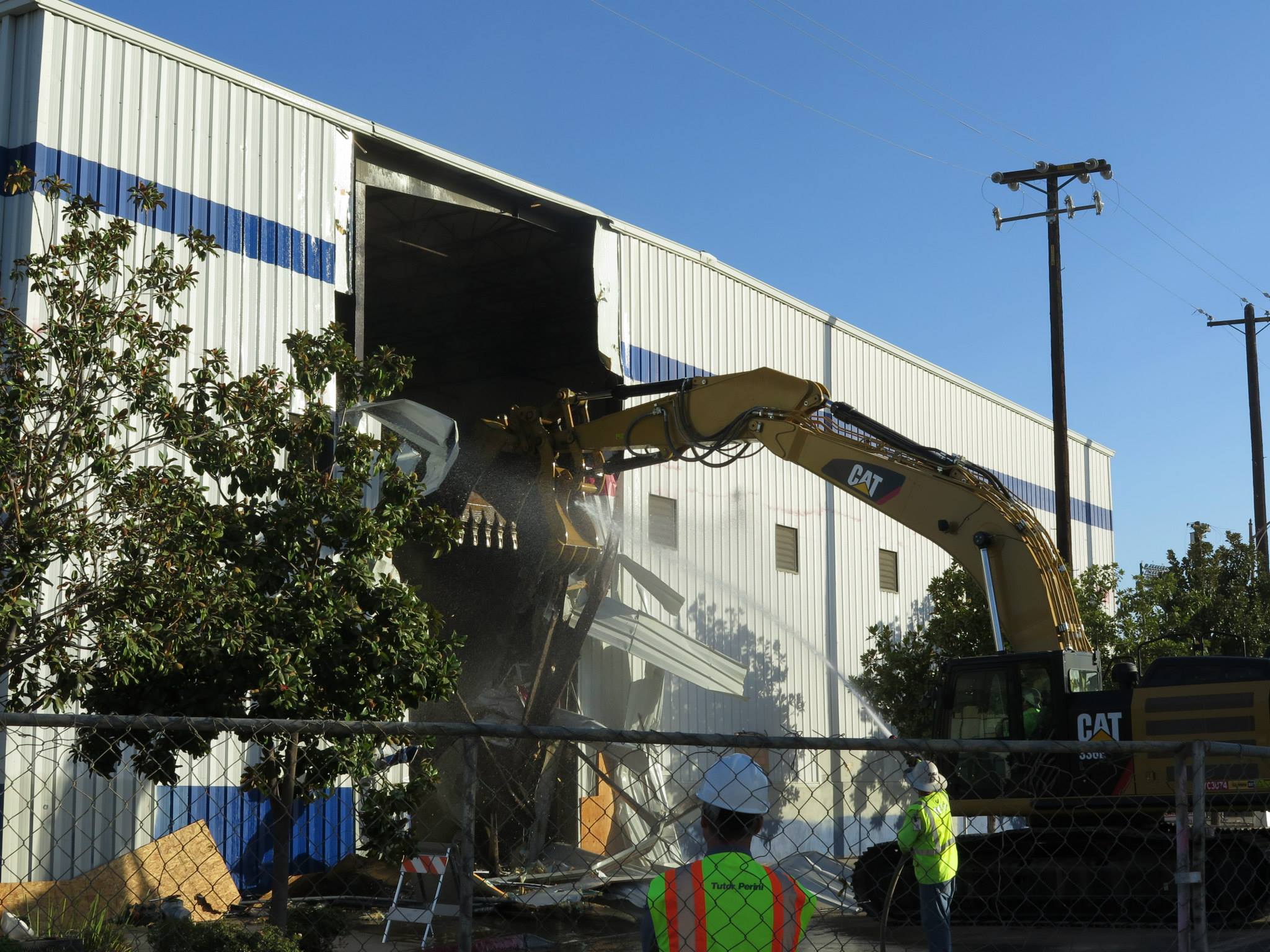
Demolition of the Old Del Monte Plant in Downtown Fresno.
(Credit: California High-Speed Rail Authority)
The Authority is beefing up our staff in the Central Valley, where construction began this summer with the demolition of buildings in Fresno. Crews continue to run tests on soil, concrete, rebar and asphalt to determine where to locate bridges, embankments and other high-speed rail structures. They’re also relocating utilities and doing abatement work which will make old abandoned buildings safe to demolish.
In light of all this activity, we are meeting and working with local communities to keep them updated on our progress. Our Central Valley office, located in Fresno, is at the center of work being done. They receive inquiries every day from the public, media, elected officials and property owners who want to be kept updated on the project or will be personally impacted. Staff in the Fresno office is committed to working with members of the public to ensure that the construction process moves forward as smoothly as possible.
The first stretch of construction will be between Fresno and Madera. What are some challenges that this area presents?
With any major infrastructure project, there will be the normal challenges associated with construction. The design-build team, Tutor Perini/Zachry/Parsons (TPZP), A Joint Venture, continues to move forward with completing project design, acquiring permits, relocating utilities and meeting with stakeholders to start the civil engineering work that will provide the foundation for the future high-speed rail.
The Authority has also entered into an agreement with the San Joaquin Valley Air Pollution Control District (SJVAPCD) to ensure that all emissions created during construction activities do not negatively impact local communities. This is being done through a series of voluntary emissions reduction agreement (VERA) that include a commitment by the Authority to recycle steel and concrete from demolitions and to use only Tier IV construction diesel vehicles while building the high-speed rail program. Tier IV diesel vehicles are the cleanest and most energy efficient construction vehicles available. The Authority is also partnering with SJVAPCD to purchase electric and efficient motors to replace existing irrigation pumps and engines, including in school buses, throughout the region.
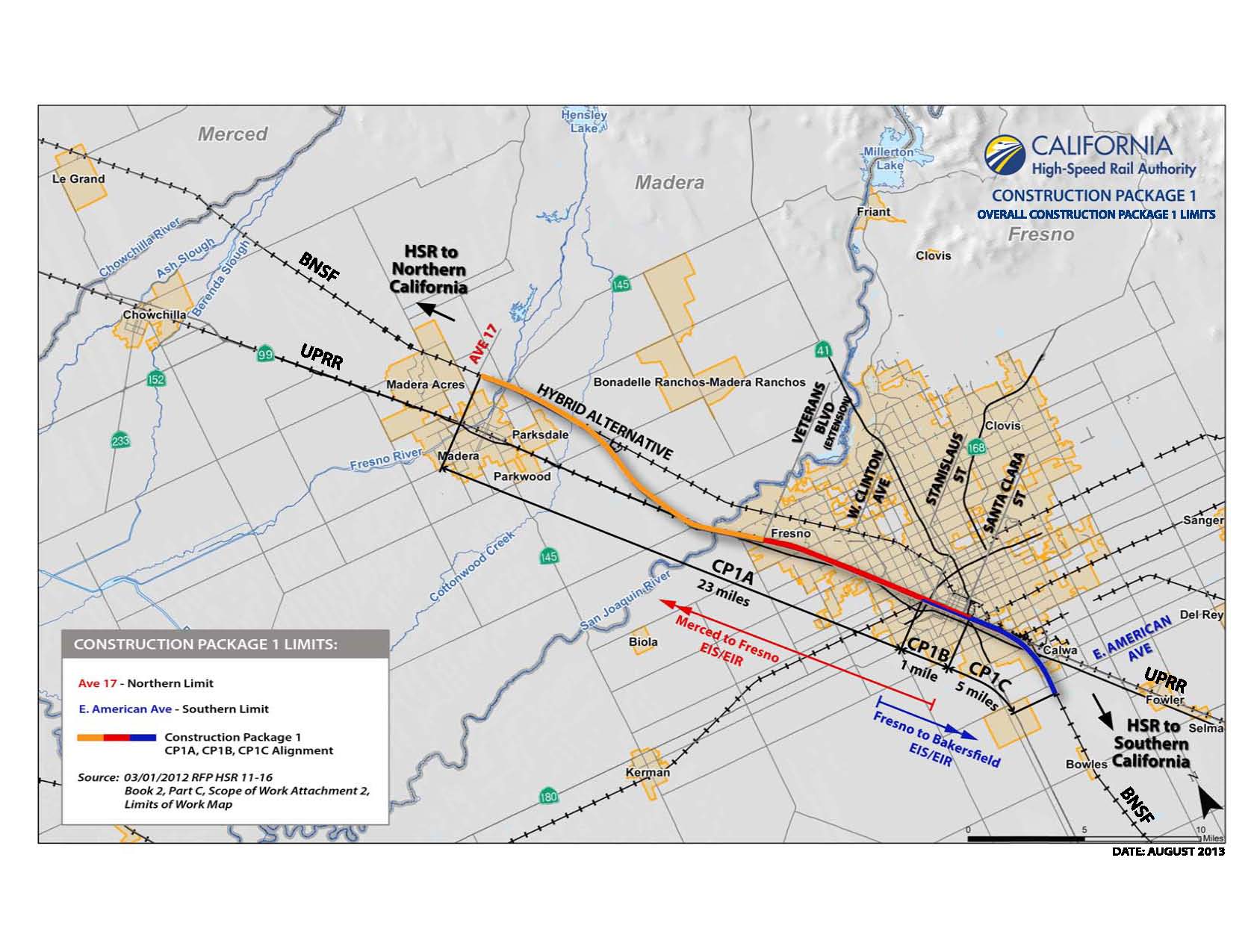
The first segment of construction will take place between Fresno to Madera.
(Credit: California High-Speed Rail)
How do you keep the public informed during construction? What communication methods and tools do you use?
The Authority is committed to keeping people informed about how the high-speed rail program will impact them. The Central Valley office, led by the Regional Director, is responsible for working with members of the public and the media to make sure that they are aware and informed. Within this office, there are engineers, right-of-way agents, planners, communications and other staff that cover a wide range of topics and are available to meet with stakeholders.
The design-build contractor (TPZP) and the Authority are partnering to keep members of the public up to date on how construction activities may impact them. This includes construction and traffic alerts that are issued when major construction is happening, community events that are held in regions that will be impacted by future construction and media events and outreach to the public.
The Authority also sends press releases and advisories to the media and to its stakeholders via email. The Authority’s website www.hsr.ca.gov contains all the latest news and updates as well as information about our ongoing construction, traffic alerts, board meetings, public meetings, etc. The public can also email us, write us a letter or give us a call at any time.
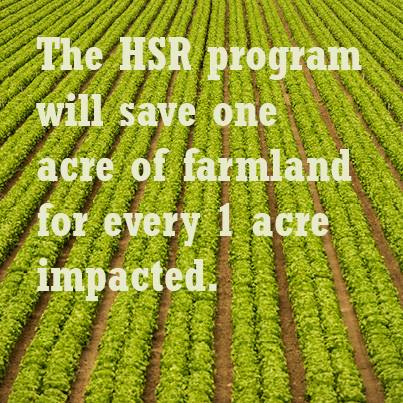
Credit: California High-Speed Rail Facebook Page
Cost is always a sore subject with mega projects. What strategies help the most to explain or prove the future value of the infrastructure?
High-speed rail is the most cost-effective method of transportation that will not only accommodate California’s population boom, but it will help preserve farmland and the environment. Los Angeles to San Francisco is the busiest short-haul market in the country. One out of six flights heads out of Los Angeles to the Bay Area. High-speed rail fills a gap in California’s infrastructure. According to Caltrans, it would cost $158 billion to build 4,300 new highway lane miles, 115 new additional airport gates and 4 new runway terminals that are needed for California’s growing population.
High-speed rail is using clean and renewable energy to connect the state’s population centers. We’re not asking people to stop taking flights or stop driving their cars. We’re simply providing another mode of transportation that will help preserve our environment and meet California’s population growth. In many other countries like Spain and France, there’s been a big transportation shift after high-speed rail systems were built. More people are using high-speed rail than driving or flying in between major cities. This has resulted in a major reduction of greenhouse gas emissions and fuel used to make the same trip by plane or car.
Can you estimate how many jobs will be created as part of Phase 1 of the California High-Speed Rail? What about after the entire project is complete and operating?
Once the Initial Operating Section (IOS) is completed, high-speed rail is estimated to generate 57,000 construction jobs annually for nine years. When Phase 1 of the project is completed, it’s estimated to create 67,000 construction jobs annually for 15 years. Currently, we do not have job estimates for Phase 2, but as you can imagine, that would create tens of thousands of more jobs throughout the state. As mentioned previously, high-speed rail will also be creating jobs in other sectors like operation, maintenance, commercial and retail.
Today in the Central Valley, small businesses are already working on the high-speed program and growing their companies as a result.
Kroeker, Inc. is a woman-owned certified Small Business Enterprise (SBE) based in Fresno that is contracted to do demolition work. Owner Jill Kroeker says the funds her company is earning through this contract has allowed her to grow and expand her company. Specifically, she reports that this spring, she moved her company into a larger office in Clovis and has been able to hire a project manager. She plans to hire more employees as the job progresses.
Another example is Fontana-based Martinez Steel. They are a certified Hispanic Owned Micro-Business (MB) and certified Disadvantaged Business Enterprise (DBE) owned by husband and wife Joe and Debbie Martinez. Their company has been contracted to provide rebar for the first 29 miles of construction. Debbie tells us her company was hit hard by the recession but this new contract has really turned things around. They’ve been able to hire 50 to 60 new workers to work on the high-speed program.
We are still years away from the completion of the California High-Speed Rail, but what are some of the benefits the public has to look forward to?
With the passage of Senate Bill 1029 in 2012 by Governor Brown and the California Legislature, the Authority has already invested in a number of connectivity projects across the state that will upgrade and improve local rail transit services. SB 1029 invests almost $2 billion of Prop 1A funds into transit, commuter and intercity rail projects across California. This funding will leverage approximately $5 billion in additional funding for these projects.
One of these projects is the Metro Connector Project in LA County, which just held its groundbreaking ceremony in Little Tokyo on Sept. 30, 2014. The 1.9-mile subway project will tie the existing Blue Line, Expo Line and Gold Line with tracks between 7th/Metro Center and Little Tokyo. For the first time, passengers will be able to travel from Long Beach to Azusa or from East LA to Santa Monica, without changing trains. This $1.4 billion project is set to open in 2020.
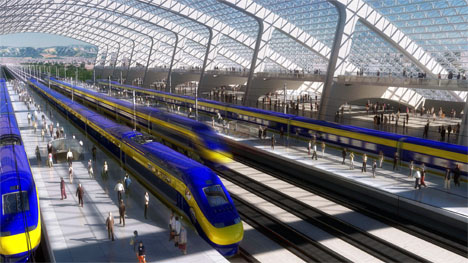
An artist conception of a California High-Speed Rail station
(Credit: California High-Speed Rail Authority)
The Authority is also investing in the Southern California Regional Interconnector Project (SCRIP) at Los Angeles Union Station. This project would create run through tracks, allowing trains to make a loop instead of having to back in and out in its current configuration. This will increase train capacity by 40 to 50 percent and reduce commuter travel times and greenhouse gas emissions. The $350 million project is expected to be completed by December 2019.
In San Diego County, the Authority is investing millions of dollars to improve grade crossings, tracks and signaling for the Trolley system. We are also investing in Positive Train Control for the North County Transit District. This is an advanced signaling system that will track the location of trains to avoid collisions.
In the Bay Area, the Authority is electrifying the Caltrain Corridor that will replace diesel trains and connect the system with high-speed rail. This will result in cleaner, faster travel.
These are just a few of the transit projects the Authority is funding and improving to make rail passenger service better and faster throughout the state.
The public will also see environmental benefits with these connectivity projects moving forward in the short term. More efficient, electric trains will reduce greenhouse gas emissions and air particulates. As more people get out of their cars and into mass transit, this will result in a reduction of vehicles on the roads. Once high-speed rail is fully operational by 2030, the reduction in Vehicle Miles Traveled (VMT) will be like removing the capacity of one 500-mile lane of cars.
The Central Valley will also be the first region in the state where the Authority will be implementing an urban forestry program. In the next several years, the Authority will work with local stakeholders to plant 10,000 trees in the region. These trees will help offset construction emissions, provide shade and beautify the surroundings. The Authority is also committed to protecting important farmland in the region and is partnering with the California Department of Conservation to purchase property from willing sellers to protect that land permanently from future development. What that means is that for every acre that will be utilized by the high-speed rail project, one acre will be preserved forever.

Members of the Fresno County Economic Development Corporation staff at a “Careers in Construction” workshop showing their support for the California High-Speed Rail by participating in the #Iwillride campaign.
(Credit: California High-Speed Rail Facebook page)
What are some ways our readers can support more high-speed rail in the U.S.?
Readers can follow the progress of California’s high-speed rail program through our social media sites. We’re constantly updating our progress through Facebook, Twitter, LinkedIn, and now Instagram. We’re also using the social media sites to update Californians on jobs, regional transportation upgrades, and how cities and regions can use transit oriented development to encourage healthier and smarter planned communities.
We encourage supporters of high-speed rail to join our #Iwillride social media campaign. Follow us on Facebook, Twitter, Instagram and YouTube and use the #Iwillride to post stories, pictures and videos about high-speed rail, riding mass transit, etc.
In addition, you can write to your local representatives and newspapers about why high-speed rail is important and needed in California. And finally, take local transit when available and encourage your family and friends to do the same. It’s tough to convince Californians to get out of their cars and use mass transit, but getting one car off the road adds up when thousands of people do it.
– – –
Will you ride the California High-Speed Rail when it’s complete? Share your thoughts on the BIG project with us.
Liz Faris, Account Manager
Collaborative Services, Inc.

Recent Comments